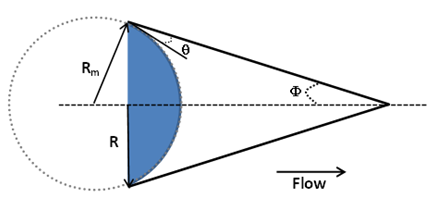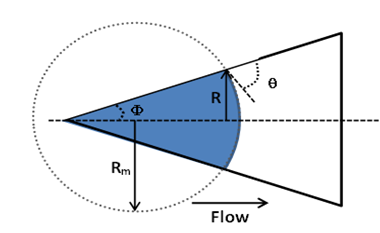Fundamentals of Fluid Flow in Porous Media
Chapter 2
Multi-phase Saturated Rock Properties:
Effect of Pore Geometry on Capillary Pressure
Capillary pressure is affected by the geometry of a given porous medium. The following section discusses the effects of flow into and out of a constriction.
In the case of fluid flowing into a constriction (Figure 2‑53), pressure is needed to force the non-wetting phase into the constriction and the wetting phase out of the constriction. According to the figure:

The equation for capillary pressure then becomes:

Where, R decreases from left to right (in the direction of flow) resulting in an increased Pc, allowing the meniscus to move from left to right into the constriction.

Figure 2-53: Flow Into a Constriction (Cone)
Figure 2‑54 shows an example of a fluid flowing out of a constriction, Pc decreases with position as meniscus moves from left to right in the direction shown in this figure. According to the figure:

The equation for capillary pressure becomes:

In order to change the position of the meniscus Pnw, Pw or R may be altered (all other parameters are fixed).

Figure 2-54: Flow Out of a Constriction
Questions?
If you have any questions at all, please feel free to ask PERM! We are here to help the community.
